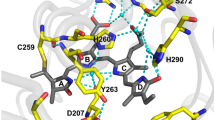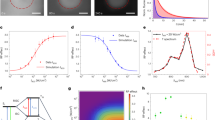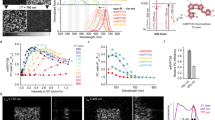Abstract
Proteins of the green fluorescent protein (GFP) family are well known owing to their unique biochemistry and extensive use as in vivo markers. We discovered that GFPs of diverse origins can act as light-induced electron donors in photochemical reactions with various electron acceptors, including biologically relevant ones. Moreover, via green-to-red GFP photoconversion, this process can be observed in living cells without additional treatment.
This is a preview of subscription content, access via your institution
Access options
Subscribe to this journal
Receive 12 print issues and online access
$259.00 per year
only $21.58 per issue
Buy this article
- Purchase on Springer Link
- Instant access to full article PDF
Prices may be subject to local taxes which are calculated during checkout


Similar content being viewed by others
References
Lippincott-Schwartz, J. & Patterson, G.H. Science 300, 87–91 (2003).
Matz, M.V. et al. Nat. Biotechnol. 17, 969–973 (1999).
Shagin, D.A. et al. Mol. Biol. Evol. 21, 841–850 (2004).
Deheyn, D.D. et al. Biol. Bull. 213, 95–100 (2007).
Verkhusha, V.V. & Lukyanov, K.A. Nat. Biotechnol. 22, 289–296 (2004).
Chudakov, D.M., Lukyanov, S. & Lukyanov, K.A. Trends Biotechnol. 23, 605–613 (2005).
Pakhomov, A.A. & Martynov, V.I. Chem. Biol. 15, 755–764 (2008).
Lukyanov, K.A., Chudakov, D.M., Lukyanov, S. & Verkhusha, V.V. Nat. Rev. Mol. Cell Biol. 6, 885–891 (2005).
Shaner, N.C., Patterson, G.H. & Davidson, M.W. J. Cell Sci. 120, 4247–4260 (2007).
Elowitz, M.B., Surette, M.G., Wolf, P.E., Stock, J. & Leibler, S. Curr. Biol. 7, 809–812 (1997).
Sawin, K.E. & Nurse, P. Curr. Biol. 7, R606–R607 (1997).
Takahashi, E. et al. Am. J. Physiol. Cell Physiol. 291, C781–C787 (2006).
Jakobs, S., Schauss, A.C. & Hell, S.W. FEBS Lett. 554, 194–200 (2003).
Gross, L.A., Baird, G.S., Hoffman, R.C., Baldridge, K.K. & Tsien, R.Y. Proc. Natl. Acad. Sci. USA 97, 11990–11995 (2000).
Moore, G.T. & Pettigrew, G.W. Cytochrome c: Evolutionary, Structural and Physicochemical Aspects (Springer-Verlag, New York, 1990).
Dym, O. & Eisenberg, D. Protein Sci. 10, 1712–1728 (2001).
Kiseleva, Iu.V., Mishin, A.S., Bogdanov, A.M., Labas, Iu.A. & Luk'ianov, K.A. Bioorg. Khim. 34, 711–715 (2008).
Go, Y.M. & Jones, D.P. Biochim. Biophys. Acta 1780, 1273–1290 (2008).
Labas, Y.A. et al. Proc. Natl. Acad. Sci. USA 99, 4256–4261 (2002).
Remington, S.J. et al. Biochemistry 44, 202–212 (2005).
Pletneva, N. et al. Acta Crystallogr. D Biol. Crystallogr. 62, 527–532 (2006).
Krasnovsky, A.A. Dokl. Akad. Nauk SSSR 60, 421–424 (1948).
Krasnovsky, A.A. Annu. Rev. Plant Physiol. 11, 363–410 (1960).
Massey, V. & Palmer, G.H. Biochemistry 5, 3181–3189 (1966).
Alieva, N.O. et al. PLoS One 3, e2680 (2008).
Acknowledgements
This work was supported by the MCB program of the Russian Academy of Sciences, the Russian Federal Agency for Science and Innovations (grant 02.513.12.3013), Howard Hughes Medical Institute (grant 55005618), the European Commission Sixth Framework Programme (LSHG-CT-2003-503259), the Russian Foundation for Basic Research (grants 07-04-12189-ofi and 09-04-00356-a), and the program “State Support of the Leading Scientific Schools” (NS-2395.2008.4). D.M.C. and K.A.L. are supported by the Russian Science Support Foundation and by grants from the president of the Russian Federation (MK-6119.2008.4 and MD-5815.2008.4). V.V.V. was supported by grant GM073913 from the US National Institutes of Health.
Author information
Authors and Affiliations
Corresponding author
Supplementary information
Supplementary Text and Figures
Supplementary Figures 1–4, Supplementary Tables 1 and 2, and Supplementary Methods (PDF 153 kb)
Rights and permissions
About this article
Cite this article
Bogdanov, A., Mishin, A., Yampolsky, I. et al. Green fluorescent proteins are light-induced electron donors. Nat Chem Biol 5, 459–461 (2009). https://doi.org/10.1038/nchembio.174
Received:
Accepted:
Published:
Issue Date:
DOI: https://doi.org/10.1038/nchembio.174
This article is cited by
-
Chromophore reduction plus reversible photobleaching: how the mKate2 “photoconversion” works
Photochemical & Photobiological Sciences (2021)
-
A general strategy to red-shift green fluorescent protein-based biosensors
Nature Chemical Biology (2020)
-
Cathodoluminescence of green fluorescent protein exhibits the redshifted spectrum and the robustness
Scientific Reports (2020)
-
Redox crosstalk at endoplasmic reticulum (ER) membrane contact sites (MCS) uses toxic waste to deliver messages
Cell Death & Disease (2018)
-
Significant expansion and red-shifting of fluorescent protein chromophore determined through computational design and genetic code expansion
Biophysics Reports (2018)



